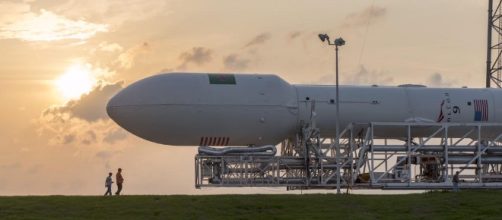Space News noted that SpaceX recently did s static test fire of the core stage of its Falcon Heavy launch vehicle, currently scheduled for a test launch late in the summer of 2017. The firing is a crucial step for the rollout of the long awaited and often delayed launch vehicle.
When Elon Musk announced the Falcon Heavy in 2011, with a first flight scheduled in 2013, the concept seemed simple enough. Strap three Falcon 9 first stages together and put an upper stage on top and you got the most powerful rocket since the Saturn V. But, as Musk ruefully admitted, the development process was far more difficult.
Making a central core that could accept two strapons was a work of some years. The lesson is that rocket science really is hard, whether one is a nimble, commercial company like SpaceX or stodgy old NASA.
The test launch will involve a central core and two previously flown Falcon 9s as strapons. If the test is successful, SpaceX will have acquired a capability to not only launch heavy DOD and NASA payloads but will have developed its own deep space exploration capacity.
The latter is the key for Elon Musk’s long term ambitions. He recently announced that he has two paying customers willing to be launched around the moon in a specially outfitted Dragon spacecraft on top of a Falcon Heavy. His plan to land Red Dragon probes on Mars relies on the Falcon Heavy.
The development of the Falcon Heavy has some implications for American space policy as well. NASA has been developing its own heavy lift launch vehicle, the space launch system, for the last seven years. The SLS is slated for a test launch in 2019, likely now with a crewed Orion spacecraft on top for a lunar orbiter mission. The NASA heavy lifter, unlike the Falcon Heavy, will not be reusable and therefore will be more expensive to operate. Thus, some are calling for the SLS to be scrapped on the brink of its entering into service and for NASA to rely on commercial launchers such as the Falcon Heavy.
The proposal is beguiling, but likely politically unrealistic. Besides, in its final form, the Space Launch System will have double to three times the launch capacity of the Falcon Heavy, That is a lot of lift just to throw away after spending so much money to acquire it.
For better or worse, the United States is going to have a mixed fleet of launch vehicles, which will also include the ULA Vulcan and the Blue Origin New Glenn and then New Armstrong, which will be a useful redundancy for deep space exploration going forward.

